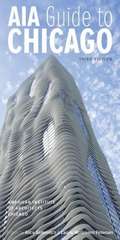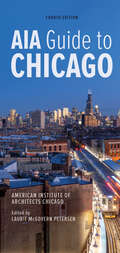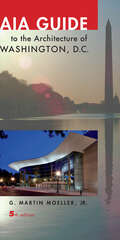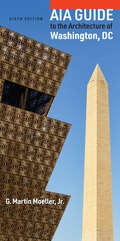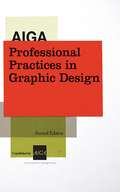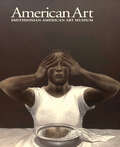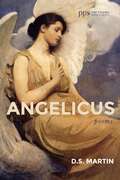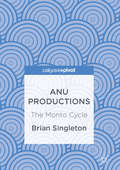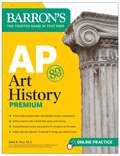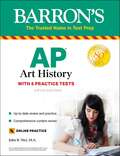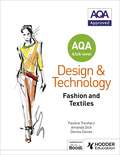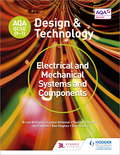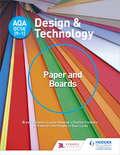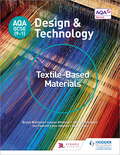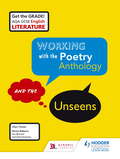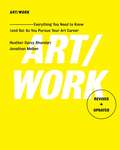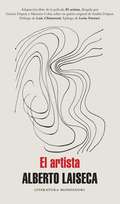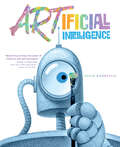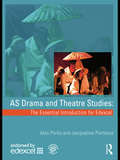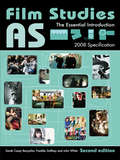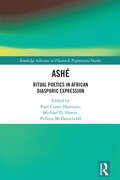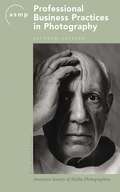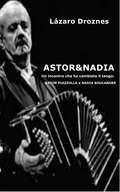- Table View
- List View
AIA Guide to Chicago
by Geoffrey Baer Alice Sinkevitch American Institute of Architects Chicago Laurie Mcgovern Petersen Perry DuisAn unparalleled architectural powerhouse, Chicago offers visitors and natives alike a panorama of styles and forms. The third edition of the AIA Guide to Chicago brings readers up to date on ten years of dynamic changes with new entries on smaller projects as well as showcases like the Aqua building, Trump Tower, and Millennium Park. Four hundred photos and thirty-four specially commissioned maps make it easy to find each of the one thousand-plus featured buildings, while a comprehensive index organizes buildings by name and architect. This edition also features an introduction providing an indispensable overview of Chicago's architectural history.
AIA Guide to Chicago
by American Institute of Architects ChicagoChicago’s architecture attracts visitors from around the globe. The fourth edition of the AIA Guide to Chicago is the best portable resource for exploring this most breathtaking and dynamic of cityscapes. The editors offer entries on new destinations like the Riverwalk, the St. Regis Chicago, and The 606 as well as updated descriptions of Willis Tower and other refreshed landmarks. Thirty-four maps and over 500 photos make it easy to find each of the almost 2000 featured sites. A special insert, new to this edition, showcases the variety of Chicago architecture with over 80 full-color images arranged chronologically. A comprehensive index organizes entries by name and architect. Sumptuously detailed and user friendly, the AIA Guide to Chicago encourages travelers and residents alike to explore the many diverse neighborhoods of one of the world’s great architectural destinations.
AIA Guide to the Architecture of Washington, D.C.
by G. Martin Moeller Jr.Third Place Winner, Design and Effectiveness Award of the Washington PublishersThis lively and informative guide offers tourists, residents, and architecture aficionados alike insights into more than 400 of Washington, D.C.’s, most important landmarks. Organized into 19 discrete tours, this thoroughly redesigned and updated edition includes 45 new entries, encompassing the House of Sweden and the U.S. Institute of Peace, classic buildings that epitomize the city—the White House, the Capitol, Union Station—and a number of private buildings off the beaten path.G. Martin Moeller, Jr., blends informed, concise descriptions with engaging commentary on each landmark, revealing often-surprising details of the buildings' history and design. Every entry is accompanied by a photograph and includes the structure's location, its architects and designers, and the corresponding dates of completion. Each entry is keyed to an easy-to-read map at the beginning of the tour.From the imposing monuments of Capitol Hill and the Mall to the pastoral suburban enclaves of Foxhall and Cleveland Park, from small memorials to vast commercial and institutional complexes, this guide shows us a Washington that is at once excitingly fresh and comfortably familiar.
AIA Guide to the Architecture of Washington, DC
by G. Martin Moeller Jr."The model of what a concise, attractive guidebook should be."—Mid-Atlantic CountryThis lively and informative guide offers tourists, residents, and architecture aficionados insights into nearly 450 of Washington, DC's, most noteworthy buildings and monuments. Organized into 19 discrete walking tours, plus one general tour of peripheral sites, this thoroughly revised sixth edition features projects ranging from early federal landmarks to twenty-first-century commercial, institutional, and residential buildings. It includes some 80 new entries covering dozens of recently completed buildings, along with some historic structures that may have been overlooked in the past. The guide also has updated maps, and many existing entries have been rewritten to reflect recent renovations, changes to the buildings' contexts, or additional scholarship.G. Martin Moeller, Jr., blends informed, concise descriptions with engaging commentary on each landmark, revealing surprising details of the buildings' history and design. Every entry is accompanied by a photograph and includes the structure's location, its architects and designers, and the corresponding dates of completion. Each entry is keyed to an easy-to-read map at the beginning of the tour.From the imposing monuments of Capitol Hill and the Mall to the pastoral suburban enclaves of Foxhall and Cleveland Park, from small memorials to vast commercial and institutional complexes, this guide shows us a Washington that is at once excitingly fresh and comfortably familiar. The additions and revisions incorporated into the latest edition illuminate broader demographic and physical changes in the city, including the emergence of new neighborhoods and the redevelopment of once-neglected areas.
AIGA Professional Practices in Graphic Design
by Tad Crawford"Provides definitive guidelines on all aspects of the graphic design business."-FYI. * Newly revised and expanded version of an industry classic--5,000 sold! * Up-to-the-minute! Includes web, interactive, and green design, new legislation * Each chapter written by an authority on the subject. Here's the definitive guide to professional business practices in graphic design, now fully revised and updated for the digital age. Up-to-the-minute coverage of web, interactive, and motion graphics; green design; potential repercussions of legislation on Orphan Works; protection of fonts and software; managing creative people; using professional help such as lawyers; and much more. Each in-depth chapter, covering such topics as professional relationships, fees, contracts, managing large projects, copyright and trademark issues, electronic uses, and more, has been written by an authority in the field. The newly revised AIGA Standard Form for Design Services is included for the convenience of readers, along with a complete resources section. No designer should do business without this comprehensive, authoritative book.
AMART vol 33 num 3
by The University of Chicago PressThis is volume 33 issue 3 of American Art. American Art publishes innovative peer-reviewed scholarship on the history of art and related visual culture. The journal critically engages with the material and conceptual conditions of art and provides a forum for the expanding field of American art history. It welcomes scholarship on the role played by art in the ongoing transnational and transcultural formation of America as a contested geography, identity, and idea. Committed to rigorous inquiry, the journal presents a range of approaches to the production and consumption of art.
ANCELICUS: poems
by D. S. MartinHave you ever stopped to consider what the angels who look in on our lives might think? Angelicus is a collection of sixty-four poems, all of which are written from the point of view of angels. By approaching from such a unique perspective, the familiar becomes draped with unfamiliarity, and the earthbound is suddenly open to heavenly insights. The poems range from interactions with ideas of angels from pop culture, to commentary on significant works of art, to expositions on scriptural stories, to scenes from everyday life. A large number of these poems have appeared in significant periodicals including Christian Century, Practical Theology (UK), Event (Canada), and The Windhover.
ANU Productions: The Monto Cycle
by Brian SingletonThis book sets out strategies of analysis of the award-winning tetralogy of performances (2010-14) by ANU Productions known as 'The Monto Cycle'. Set within a quarter square mile of Dublin's north inner city, colloquially known as The Monto, these performances featured social concerns that have blighted the area over the past 100 years, including prostitution, trafficking, asylum-seeking, heroin addiction, and the scandal of the Magdalene laundries. While placing the four productions in their social, historical, cultural and economic contexts, the book examines these performances that operated at the intersection of performance, installation, visual art, choreography, site-responsive and community arts. In doing so, it explores their concerns with time, place, history, memory, the city, 'affect', and the self as agent of action.
AP Art History Premium, Sixth Edition: Prep Book with 5 Practice Tests + Comprehensive Review + Online Practice (Barron's AP Prep)
by John B. Nici M.A. Barron's Educational SeriesBe prepared for exam day with Barron&’s. Trusted content from AP experts!Barron&’s AP Art History Premium, Sixth Edition includes in‑depth content review and practice. It&’s the only book you&’ll need to be prepared for exam day. Written by Experienced EducatorsLearn from Barron&’s‑‑all content is written and reviewed by AP expertsBuild your understanding with comprehensive review tailored to the most recent examGet a leg up with tips, strategies, and study advice for exam day‑‑it&’s like having a trusted tutor by your sideBe Confident on Exam DaySharpen your test‑taking skills with 5 full‑length practice tests‑‑3 in the book, including a diagnostic test to target your studying, and 2 more online–plus detailed answer explanations for all questionsStrengthen your knowledge with in‑depth review covering all units on the AP Art History examReinforce your learning with practice questions at the end of each chapterLearn to think like an art historian by reviewing hundreds of clear figures and key details about how they were made, their significance in history, and how to interpret and compare them to other famous works of artRobust Online PracticeContinue your practice with 2 full‑length practice tests on Barron&’s Online Learning HubSimulate the exam experience with a timed test optionDeepen your understanding with detailed answer explanations and expert adviceGain confidence with scoring to check your learning progress
AP Art History: With 5 Practice Tests (Barron's Test Prep)
by John B. Nici M.A.Barron&’s AP Art History with 5 Practice Tests is aligned with the College Board&’s AP course and provides comprehensive review and practice for the exam.This edition includes:One diagnostic test and two full-length practice exams in the book with all questions answered and explainedTwo full-length online practice tests with answers and explanationsArt history review describing major artists and art movements400 online flashcards to help students review required works of artMultiple-choice questions and practice essays after every chapter
AP® Art History Crash Course Book + Online (Advanced Placement (AP) Crash Course)
by Gayle A. Asch Matt CurlessREA's Crash Course for the AP® Art History Exam - Gets You a Higher Advanced Placement® Score in Less Time 2nd Edition - Completely Revised for the New 2016 ExamCrash Course is perfect for the time-crunched student, the last-minute studier, or anyone who wants a refresher on the subject. Are you crunched for time? Have you started studying for your Advanced Placement® Art History exam yet? How will you memorize everything you need to know before the test? Do you wish there was a fast and easy way to study for the exam AND boost your score? If this sounds like you, don't panic. REA's Crash Course for AP® Art History is just what you need. Our Crash Course gives you: Targeted, Focused Review - Study Only What You Need to Know The Crash Course is based on an in-depth analysis of the new AP® Art History course description outline and actual AP® test questions. It covers only the information tested on the exam, so you can make the most of your valuable study time. Written by an AP® Art History teacher, the targeted review prepares students for the 2016 test by focusing on the new framework concepts and learning objectives tested on the redesigned AP® Art History exam. Easy-to-read review chapters in outline format cover all the artistic traditions students need to know, including Global Prehistory, Ancient Mediterranean, Europe and the Americas, Asia, Africa, and more. The book also features must-know Art History terms all AP® students should know before test day.Expert Test-taking StrategiesOur experienced AP® Art History teacher shares detailed question-level strategies and explains the best way to answer the multiple-choice and free-response questions you'll encounter on test day. By following our expert tips and advice, you can boost your overall point score! FREE Practice Exam After studying the material in the Crash Course, go to the online REA Study Center and test what you've learned. Our free practice exam features timed testing, detailed explanations of answers, and automatic scoring analysis. The exam is balanced to include every topic and type of question found on the actual AP® exam, so you know you're studying the smart way. Whether you're cramming for the test at the last minute, looking for extra review, or want to study on your own in preparation for the exams - this is the study guide every AP® Art History student must have. When it's crucial crunch time and your Advanced Placement® exam is just around the corner, you need REA's Crash Course for AP® Art History!
AQA AS/A-Level Design and Technology: Fashion and Textiles
by Amanda Dick Pauline Treuherz Denise DaviesExam board: AQALevel: A-levelSubject: Design and TechnologyFirst teaching: September 2017First exams: Summer 2018 (AS) Summer 2019 (A-Level)Encourage your students to be creative, innovative and critical designers with a textbook that builds in-depth knowledge and understanding of the materials, components and processes associated with the creation of fashion and textile products.Our experienced author team will help guide you through the requirements of the specification, covering the core technical and designing and making principles needed for the 2017 AQA AS and A-level Design and Technology Fashion and Textiles specification.- Explores real-world contexts for fashion and textiles- Develops practical skills and theoretical knowledge and builds student confidence- Supports students with the application of maths skills to fashion and textiles- Helps guide students through the requirements of the Non-Exam Assessments and the written exams at both AS and A-level
AQA AS/A-Level Design and Technology: Fashion and Textiles
by Amanda Dick Pauline Treuherz Denise DaviesExam board: AQALevel: A-levelSubject: Design and TechnologyFirst teaching: September 2017First exams: Summer 2018 (AS) Summer 2019 (A-Level)Encourage your students to be creative, innovative and critical designers with a textbook that builds in-depth knowledge and understanding of the materials, components and processes associated with the creation of fashion and textile products.Our experienced author team will help guide you through the requirements of the specification, covering the core technical and designing and making principles needed for the 2017 AQA AS and A-level Design and Technology Fashion and Textiles specification.- Explores real-world contexts for fashion and textiles- Develops practical skills and theoretical knowledge and builds student confidence- Supports students with the application of maths skills to fashion and textiles- Helps guide students through the requirements of the Non-Exam Assessments and the written exams at both AS and A-level
AQA GCSE (9-1) Design and Technology: Electrical and Mechanical Systems and Components
by Bryan Williams Louise Attwood Pauline TreuherzBuild in-depth understanding and inspire your students to tackle design challenges both practically and creatively, with a textbook that delivers the Core Technical plus Specialist Technical and Design & Making Principles needed for the 2017 AQA D&T GCSE.The insight of our author team will build topic knowledge, including the technical principles of materials with which you are less familiar, while focusing on the specialist principles of electrical and mechanical systems and components in more depth, to ensure you can navigate the specification with confidence whilst your students' ideas flourish.· Trusted author team of specialist teachers and those with examining experience· Build topic knowledge with learning objectives directly linked to the specification and short activities to reinforce understanding· Develop mathematical and scientific knowledge and understanding with activities that link topics to maths and science· Inspire your students as they undertake the iterative design process, with examples of imaginative design-and-make tasks, and a look at how to approach the Non-Exam Assessment· Check knowledge and understanding with end of topic summaries and practice questions for the written exam
AQA GCSE (9-1) Design and Technology: Paper and Boards
by Bryan Williams Louise Attwood Pauline TreuherzBuild in-depth understanding and inspire your students to tackle design challenges both practically and creatively, with a textbook that delivers the Core Technical plus Specialist Technical and Design & Making Principles needed for the 2017 AQA D&T GCSE.The insight of our author team will build topic knowledge, including the technical principles of materials with which you are less familiar, while focusing on the specialist principles of paper and boards in more depth, to ensure you can navigate the specification with confidence whilst your students' ideas flourish.· Trusted author team of specialist teachers and those with examining experience· Build topic knowledge with learning objectives directly linked to the specification and short activities to reinforce understanding· Develop mathematical and scientific knowledge and understanding with activities that link topics to maths and science· Inspire your students as they undertake the iterative design process, with examples of imaginative design-and-make tasks, and a look at how to approach the Non-Exam Assessment· Check knowledge and understanding with end of topic summaries and practice questions for the written exam
AQA GCSE (9-1) Design and Technology: Textile-Based Materials
by Bryan Williams Louise Attwood Pauline TreuherzBuild in-depth understanding and inspire your students to tackle design challenges both practically and creatively, with a textbook that delivers the Core Technical plus Specialist Technical and Design & Making Principles needed for the 2017 AQA D&T GCSE.The insight of our author team will build topic knowledge, including the technical principles of materials with which you are less familiar, while focusing on the specialist principles of textile-based materials in more depth, to ensure you can navigate the specification with confidence whilst your students' ideas flourish.· Trusted author team of specialist teachers and those with examining experience· Build topic knowledge with learning objectives directly linked to the specification and short activities to reinforce understanding· Develop mathematical and scientific knowledge and understanding with activities that link topics to maths and science· Inspire your students as they undertake the iterative design process, with examples of imaginative design-and-make tasks, and a look at how to approach the Non-Exam Assessment· Check knowledge and understanding with end of topic summaries and practice questions for the written exam
AQA GCSE English Literature Working with the Poetry Anthology and the Unseens Student Book
by Alan HoweSExam Board: AQALevel: GCSESubject: EnglishFirst Teaching: September 2015First Exam: June 2017upport your students in developing the skills required to understand and respond to every studied poem in the 2015 AQA Poetry Anthology- Teaches students how to analyse seen and unseen poems by moving gradually from first impressions to detailed explorations with thought-provoking questions at each stage- Provides approaches to learning all 30 poems in the AQA Anthology, including vital guidance for writing comparison answers- Ensures students are prepared for examination with a focus on the skills needed to succeed and how to tackle the different question types in Paper 2
ART/WORK: Everything You Need to Know (and Do) As You Pursue Your Art Career
by Heather Darcy Bhandari Jonathan MelberThe definitive, must-have guide to pursuing an art career—the fully revised and updated edition of Art/Work, now in its fourteenth printing, shares the tools artists of all levels need to make it in this highly competitive field.Originally published in 2009, Art/Work was the first practical guide to address how artists can navigate the crucial business and legal aspects of a fine art career. But the rules have changed since then, due to the proliferation of social media, increasing sophistication of online platforms, and ever more affordable digital technology. Artists have never had to work so hard to distinguish themselves—including by making savvy decisions and forging their own paths. Now Heather Bhandari, with over fifteen years of experience as a director of the popular Chelsea gallery Mixed Greens, and Jonathan Melber, a former arts/entertainment lawyer and director of an art e-commerce startup, advise a new generation of artists on how to make it in the art world. In this revised and updated edition, Bhandari and Melber show artists how to tackle a host of new challenges. How do you diversify income streams to sustain a healthy art practice? How can you find an alternative to the gallery system? How do you review a license agreement? What are digital marketing best practices? Also included are new quotes from over thirty arts professionals, updated commission legal templates, organizational tips, tax information, and advice for artists who don’t make objects. An important resource for gallerists, dealers, art consultants, artist-oriented organizations, and artists alike, Art/Work is the resource that all creative entrepreneurs in the art world turn to for advice.
ARTISTA, EL (EBOOK)
by Alberto Laiseca"Obra conjunta Alberto Laiseca, los hermanos Duprat, Mariano Cohn, León Ferrari, nada complaciente, El artista revela que sí, que la inspiración es posible: la belleza esquiva, inasible, la notación rápida, frugal, fugaz a lo Stendhal, el desenlace balzaciano. Es admirable que lo riesgoso adquiera un matiz gratificante, asombroso, pero es lo que ocurre en este caso: nos asomamos, nos aventuramos, y recibimos una recompensa a la altura de la curiosidad, de la expectativa. La vida oscurece las diferencias entre la vida y el arte, como pregonaba (o acaso sólo implorara) Cage, y una investigación seria sobre los valores y posibilidades del arte en la cultura actual puede despejarse del malestar inherente a las capillas y las jergas y resultar, a la vez, un entretenimiento amable, un relato entrañable." Luis Chitarroni
ARTificial Intelligence
by David BiedrzyckiEver since he was a little chip, Robot knew he was ART-ificially different. A funny and heartfelt picture book exploring AI, art, and creativity.Try as he might, Robot can't keep up with the other robots at the warehouse. But when he's sent off for reprogramming, he takes a wrong turn and ends up encountering music, dancing, and ART! He tries to share his discovery, only to find that art is hard to explain—and even harder to do. Will Robot learn to express himself and transform the warehouse . . . or will he be recycled?
AS Drama and Theatre Studies: The Essential Introduction for Edexcel
by Alan Perks Jacqueline PorteousAS Drama and Theatre Studies: The Essential Introduction for Edexcel is a comprehensive and accessible guide to the new specification. The textbook covers all aspects of the AS year in depth, from exploring play texts to demonstrating skills in performance and theatre design. The detailed guidance and classroom-friendly features include: overviews of specification and assessment requirements written and practical exercises tips from a Chief Examiner extension exercises to stretch the more able student worked examples to illustrate best practice a glossary of useful words and terms. Written by a Chief Examiner and a Principal Moderator, this authoritative book offers a wealth of informed and supportive exercises to ensure that students reach their maximum potential.
AS Film Studies: The Essential Introduction
by John White Freddie Gaffney Sarah Casey BenyahiaAS Film Studies: The Essential Introduction gives students the confidence to tackle every part of the WJEC AS level Film Studies course. The authors, who have wide ranging experience as teachers, examiners and authors, introduce students step by step, to the skills involved in the study of film. The second edition follows the new WJEC syllabus for 2008 teaching onwards and has a companion website with additional resources for students and teachers. Specifically designed to be user friendly, the second edition of AS Film Studies: The Essential Introduction has a new text design to make the book easy to follow, includes more than 100 colour photographs and is jam packed with features such as: Case studies relevant to the 2008 specification Activities on films including Little Miss Sunshine, Pirates of the Caribbean & The Descent Key terms Example exam questions Suggestions for further reading and website resources
ASHÉ: Ritual Poetics in African Diasporic Expression (Routledge Advances in Theatre & Performance Studies)
by Michael D. Harris Paul Carter Harrison Pellom McDaniels III‘ASHÉ: Ritual Poetics in African Diasporic Expressivity' is a collection of interdisciplinary essays contributed by international scholars and practitioners. Having distinguished themselves across such disciplines as Anthropology, Art, Music, Literature, Dance, Philosophy, Religion, and Theology and conjoined to construct a defining approach to the study of Aesthetics throughout the African Diaspora with the Humanities at the core, this collection of essays will break new ground in the study of Black Aesthetics. This book will be of great interest to scholars, practitioners, and students interested in tracing African heritage identities throughout the African Diaspora through close examination of a variety of discourses directly connected to expressive elements of cultural production and religious rituals.
ASMP Professional Business Practices in Photography
by American Society of Media PhotographersAt last! The eagerly anticipated revised edition of the photographer's "business bible" is here, fully updated with the last word on key business practices, industry standards, and resources. Up-to-the-minute coverage now includes digital asset management; metadata standards; the role of Internet, FTP, and e-mail technologies; the impact of media consolidation on assignment and stock photography; and much more. This indispensable guide covers the full range of business and legal questions that photographers might have, with comprehensive advice from the ASMP, the foremost authority in the field. In eleven in-depth chapters, more than two dozen industry experts explore pricing and negotiating, ethics, rights in traditional and electronic media, publishing, and much more. Business and legal forms, checklists, and an extensive cross-media bibliography make this the one reference book that deserves a place on every successful photographer's bookshelf.
ASTOR & NADIA
by Lázaro Droznes Silvia Gallico e Marco GallicoUn incontro che ha cambiato il tango: Astor Piazzolla e Nadia Boulanger. Testo teatrale che racconta l'incontro fra Nadia Boulanger e Astor Piazzolla, un evento che influenzò profondamente la vita del musicista e la storia del tango. Da giovane, il noto autore di "Adiós Nonino", "Libertango" e "Oblivion" abbandonò il tango e il "bandoneón" per studiare e comporre musica classica. L'incontro con la nota insegnante francese di musica Nadia Boulanger aiutò Piazzolla a riscoprire la sua passione e le proprie radici musicali, a trovare il proprio stile musicale e a rivoluzionare il tango argentino con nuove tecniche. Se non avesse incontrato Nadia Boulanger Piazzolla non sarebbe stato lo stesso e il tango non sarebbe quello che conosciamo oggi. Un viaggio incredibile di scoperta e di crescita.
